Cylindrical coordinates assigned an ordered
triple ![]() to points in space. If the
rectangular coordinates of the point are
to points in space. If the
rectangular coordinates of the point are ![]() , then
, then ![]() are the polar coordinates of the point
are the polar coordinates of the point ![]() ; the third coordinate z is the same in both
cylindrical and rectangular.
; the third coordinate z is the same in both
cylindrical and rectangular.
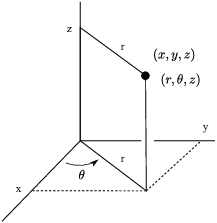
Example. A point has rectangular coordinates
![]() . Find its cylindrical
coordinates.
. Find its cylindrical
coordinates.
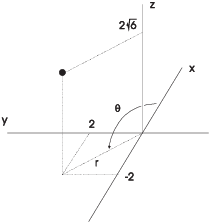
Since the point lies above the second quadrant, I've rotated the
coordinates axes so that the second quadrant is "in front".
From the picture, it's clear that ![]() . By Pythagoras,
. By Pythagoras, ![]() .
.
The cylindrical coordinates are ![]() .
.![]()
Example. A point has cylindrical coordinates
![]() . Find its
rectangular coordinates.
. Find its
rectangular coordinates.
The point lies below the fourth quadrant. Its rectangular coordinates
are ![]() .
.![]()
Example. Find the equation of the unit sphere
![]() in cylindrical coordinates.
in cylindrical coordinates.
Setting ![]() , I get
, I get
![]()
Example. Convert ![]() to cylindrical coordinates.
to cylindrical coordinates.
![]()
Example. What is the set of points which
satisfy the cylindrical coordinate equation ![]() ?
?
The equation is ![]() , so
, so ![]() or
or ![]() . The locus consists of two
concentric cylinders of radius 1 and 2 having the z-axis as their
axis.
. The locus consists of two
concentric cylinders of radius 1 and 2 having the z-axis as their
axis.
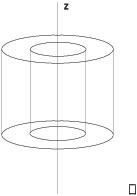
To convert a triple integral ![]() to cylindrical coordinates:
to cylindrical coordinates:
1. Convert ![]() to cylindrical coordinates
using the polar coordinate conversion equations.
to cylindrical coordinates
using the polar coordinate conversion equations.
2. To obtain the limits of integration, describe the region R by inequalities in cylindrical coordinates.
3. Replace ![]() with
with ![]() .
.
In converting a double integral from rectangular to polar, we replace
![]() with
with ![]() , so this is reasonable from that point of
view. You can see the factor of r from the change of variables
formula. The transformation is
, so this is reasonable from that point of
view. You can see the factor of r from the change of variables
formula. The transformation is
![]()
The Jacobian is
![$$\det \left[\matrix{ \cos \theta & -r \sin \theta & 0 \cr \sin \theta & r \cos \theta & 0 \cr 0 & 0 1 \cr}\right] = r (\cos \theta)^2 + r (\sin \theta)^2 = r.$$](cylindrical-coordinates31.png)
Assuming that r is positive, the change of variables formula tells us
to replace ![]() with
with ![]() .
.
Example. Let R be the region bounded below by
![]() and above by
and above by ![]() . Compute
. Compute
![]()
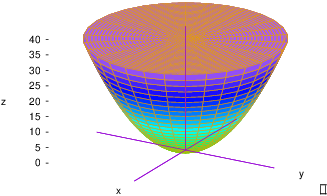
The intersection of ![]() and
and ![]() is
is ![]() , a circle of radius
6 centered at the origin. Hence, the region of integration is
, a circle of radius
6 centered at the origin. Hence, the region of integration is

Note that ![]() . The integral is
. The integral is
![]()
![]()
Copyright 2018 by Bruce Ikenaga